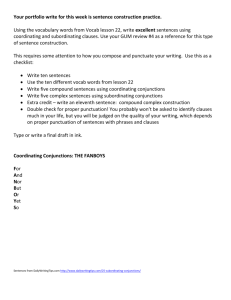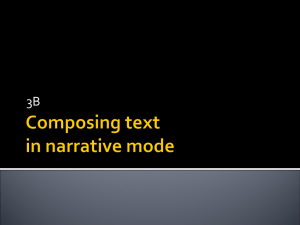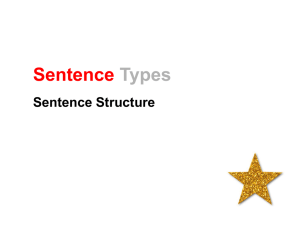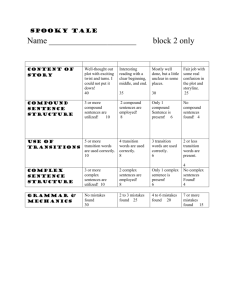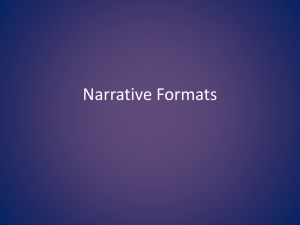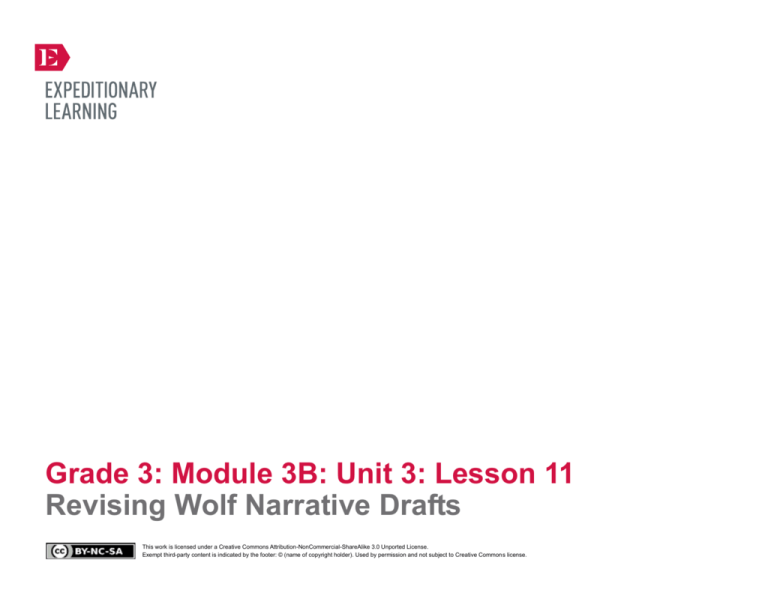
Grade 3: Module 3B: Unit 3: Lesson 11
Revising Wolf Narrative Drafts
This work is licensed under a Creative Commons Attribution-NonCommercial-ShareAlike 3.0 Unported License.
Exempt third-party content is indicated by the footer: © (name of copyright holder). Used by permission and not subject to Creative Commons license.
GRADE 3: MODULE 3B: UNIT 3: LESSON 11
Revising Wolf Narrative Drafts
Long-Term Targets Addressed (Based on NYSP12 ELA CCLS)
I can demonstrate command of the conventions of standard English grammar and usage when writing or speaking. (L.3.1)
I can use coordinating and subordinating conjunctions. (L.3.1h)
I can produce simple, compound, and complex sentences. (L.3.1i)
Supporting Learning Targets
Ongoing Assessment
• I can use coordinating and subordinating conjunctions in my Wolf Narrative.
• Revised Wolf Narrative draft
• I can write simple, complex, and compound sentences in my Wolf Narrative.
Created by Expeditionary Learning, on behalf of Public Consulting Group, Inc.
© Public Consulting Group, Inc., with a perpetual license granted to Expeditionary Learning Outward Bound, Inc.
NYS Common Core ELA Curriculum • G3:M3B:U3:L11 • June 2014 • 1
GRADE 3: MODULE 3B: UNIT 3: LESSON 11
Revising Wolf Narrative Drafts
Agenda
Teaching Notes
1. Opening
• To address language standards L.3.1h and L.3.1i, students revise their writing with these standards in
mind in this lesson. Since the standards are listed as criteria on the Narrative Writing Rubric, students
begin there to give the revisions process a purpose. Because they are linked, L.3.1h and L.3.1i are taught
simultaneously with the support of a handout of examples (Simple, Compound, and Complex Sentence
Examples), as they are linked, which will help students grasp coordinating and subordinating
conjunctions more easily.
A. Unpacking Learning Targets (5 minutes)
2. Work Time
A. Analyzing the Wolf Narrative Model: Sentence
Structure (50 minutes)
3. Closing and Assessment
A. Adding to the Criteria of a Strong Narrative Anchor
Chart (5 minutes)
4. Homework
• Students will need copies of their Wolf Narrative drafts (End of Unit 3 Assessment; from Lesson 10) to
revise them in this lesson.
• In advance:
– Copy students’ Wolf Narrative drafts if you need more time to assess the originals.
A. Continue reading your independent reading book.
– Post: Learning targets; Criteria of a Strong Narrative anchor chart.
Lesson Vocabulary
Materials
subordinating conjunctions,
coordinating conjunctions
• Narrative Writing Rubric (from Lesson 1; one to display)
• Simple, Compound, and Complex Sentence Examples (one per student and one to display)
• Wolf Narrative model (from Unit 2, Lesson 1; one per student)
• Copies of students’ completed End of Unit 3 Assessment: Drafting the Wolf Narrative (one per student)
• Lined paper (two pieces per student)
• Criteria of a Strong Narrative anchor chart (begun in Lesson 1)
Created by Expeditionary Learning, on behalf of Public Consulting Group, Inc.
© Public Consulting Group, Inc., with a perpetual license granted to Expeditionary Learning Outward Bound, Inc.
NYS Common Core ELA Curriculum • G3:M3B:U3:L11 • June 2014 • 2
GRADE 3: MODULE 3B: UNIT 3: LESSON 11
Revising Wolf Narrative Drafts
Opening
Meeting Students’ Needs
A. Unpacking Learning Targets (5 minutes)
• Direct students’ attention to the posted learning targets and read them aloud:
• Posting learning targets allows
students to reference them
throughout the lesson to check their
understanding. The learning targets
also provide a reminder to students
and teachers about the intended
learning behind a given lesson or
activity.
* “I can use coordinating and subordinating conjunctions in my Wolf Narrative.”
* “I can write simple, complex, and compound sentences in my Wolf Narrative.”
• Display the Narrative Writing Rubric.
• Point out that the second learning target is listed in the Conventions section.
• Tell students that many of the words in these learning targets may be unfamiliar at the moment, but in this lesson students
approach the learning targets one at a time to learn more about what they mean, analyze the Wolf Narrative model, and then
revise their Wolf Narrative drafts.
Work Time
Meeting Students’ Needs
A. Analyzing the Wolf Narrative Model: Sentence Structure (50 minutes)
• Explain that varying the kinds of sentences used in a story can help make the writing easier to read and sound more
interesting.
• Providing clear examples of each
kind of sentence for reference will
support struggling learners in
recognizing the difference, which
they can then apply to their own
work.
• Pair students up.
• Distribute Simple, Compound, and Complex Sentence Examples.
• Ask students to follow along silently as you read the handout aloud.
• Explain that these are three different kinds of sentences. Remind students that they learned about simple and compound
sentences in Module 2B.
• Ask students to discuss with a partner:
* “What do you notice?”
* “What do you wonder?”
• Asking students to identify
examples of each sentence type in
the model narrative will also help
them to recognize the difference,
which they can then apply to their
own work.
• Refocus whole group and select volunteers to share out their notices and wonders.
• Ask students to discuss with their partners:
Created by Expeditionary Learning, on behalf of Public Consulting Group, Inc.
© Public Consulting Group, Inc., with a perpetual license granted to Expeditionary Learning Outward Bound, Inc.
NYS Common Core ELA Curriculum • G3:M3B:U3:L11 • June 2014 • 3
GRADE 3: MODULE 3B: UNIT 3: LESSON 11
Revising Wolf Narrative Drafts
* “How are simple and compound sentences different?”
Meeting Students’ Needs
Work Time (continued)
• Cold call students to share their responses. Listen for: “A simple sentence has only one thought, whereas a compound
sentence has two thoughts. A compound sentence can be divided into two simple sentences..”
• Ask students to discuss with their partners:
* “How are compound and complex sentences different?”
• Select volunteers to share their responses. Listen for: “Compound sentences have two thoughts and can be divided into two
simple sentences. Complex sentences only have one complete thought and then another part that needs the complete
thought to make sense. Complex sentences cannot be divided into two simple sentences.”
• Explain that, according to the Narrative Writing Rubric, students need to use all of those kinds of sentences in their writing.
• Direct students’ attention to the first learning target:
* “I can use coordinating and subordinating conjunctions in my Wolf Narrative.”
• Remind students of the coordinating conjunctions listed with the compound sentence description on the simple, compound,
and complex sentence examples and remind students that coordinating conjunctions are used to join compound sentences.
• Remind students of the subordinating conjunctions listed with the complex sentence description and remind them that
subordinating conjunctions are used to begin complex sentences.
• Focus students’ attention on the complex sentence examples on the handout. Invite students to put something over the
subordinating conjunction “because” that begins the first sentence.
• Ask students to discuss in pairs:
* “What do you notice about the sentence now?”
• Select a volunteer to share his or her ideas. Listen for: “Without the subordinating conjunction at the beginning, the
sentence could be a compound sentence—two complete thoughts—if a coordinating clause was used in the middle.”
Emphasize that the subordinating clause at the beginning makes the first part of the sentence dependent on the complete
thought, which makes the sentence complex.
• Invite students to retrieve their Wolf Narrative models.
• Ask pairs to find one example of a simple sentence.
• Select a volunteer to share the sentence he or she found and clarify whether or not it is a correct example of a simple
Created by Expeditionary Learning, on behalf of Public Consulting Group, Inc.
© Public Consulting Group, Inc., with a perpetual license granted to Expeditionary Learning Outward Bound, Inc.
NYS Common Core ELA Curriculum • G3:M3B:U3:L11 • June 2014 • 4
GRADE 3: MODULE 3B: UNIT 3: LESSON 11
Revising Wolf Narrative Drafts
sentence. If the student is incorrect, use the sentence example handout to explain why.
• Ask pairs to find one example of a compound sentence.
Meeting Students’ Needs
Work Time (continued)
• Select a volunteer to share the sentence he or she found and clarify whether or not it is a correct example of a compound
sentence. If the student is incorrect, use the sentence example handout to explain why.
• Ask pairs to find one example of a complex sentence.
• Select a volunteer to share the sentence he or she found and clarify whether or not it is a correct example of a complex
sentence. If the student is incorrect, use the example handout to explain why.
• Distribute copies of End of Unit 3 Assessment: Drafting the Wolf Narrative and lined paper.
• Tell students that they are now going to revise their writing to make sure there are simple, compound, and complex
sentences in their narratives.
• Remind students to use the coordinating conjunctions listed on the sentence examples handout when connecting two simple
sentences to make a compound sentence, and to use the subordinating conjunctions when making a simple sentence
complex. Emphasize that there should still be simple sentences, and sentences should only be made compound or complex
where it makes sense to do so.
• Circulate to support students. Ask guiding questions:
* “Can you show me a simple sentence in your writing? What about a compound and a complex sentence?”
* “What coordinating conjunction could you use between these two simple sentences to make a compound sentence?”
* “What subordinating conjunction could you use here to make this a complex sentence?”
• Invite students to store their revised narratives for use in the next lesson.
Created by Expeditionary Learning, on behalf of Public Consulting Group, Inc.
© Public Consulting Group, Inc., with a perpetual license granted to Expeditionary Learning Outward Bound, Inc.
NYS Common Core ELA Curriculum • G3:M3B:U3:L11 • June 2014 • 5
GRADE 3: MODULE 3B: UNIT 3: LESSON 11
Revising Wolf Narrative Drafts
Closing and Assessment
Meeting Students’ Needs
A. Adding to the Criteria of a Strong Narrative Anchor Chart (5 minutes)
• Focus students’ attention on the Criteria of a Strong Narrative anchor chart.
• Adding new learning to the anchor
chart for future reference will
support struggling learners when
they write their final drafts, because
it provides a clear list of criteria
reflecting their learning process to
refer to.
• Ask students to discuss in pairs:
* “What do we need to add to the anchor chart based on your learning today?”
• Select volunteers to share their responses. Listen for them to list the learning targets.
• Record the following on the anchor chart: “Includes simple, compound, and complex sentences. Includes coordinating
conjunctions.”
Homework
Meeting Students’ Needs
• Continue reading your independent reading book.
Created by Expeditionary Learning, on behalf of Public Consulting Group, Inc.
© Public Consulting Group, Inc., with a perpetual license granted to Expeditionary Learning Outward Bound, Inc.
NYS Common Core ELA Curriculum • G3:M3B:U3:L11 • June 2014 • 6
Grade 3: Module 3B: Unit 2: Lesson 11
Supporting Materials
This work is licensed under a Creative Commons Attribution-NonCommercial-ShareAlike 3.0 Unported License.
Exempt third-party content is indicated by the footer: © (name of copyright holder). Used by permission and not subject to Creative Commons license.
GRADE 3: MODULE 3B: UNIT 3: LESSON 11
Simple, Compound, and Complex Sentence Examples
Simple
(One complete thought)
• I eat cereal every morning for breakfast.
• He ran after the ball.
• She drove home from work in the dark.
• I am studying for a test.
Compound
(Two or more complete thoughts—the sentence could be divided into two sentences connected by a
coordinating conjunction: and, but, for, nor, or, so, yet)
• I eat cereal every morning for breakfast and I also drink a glass of milk.
• He ran after the ball, but he tripped and fell.
• She drove home from work in the dark, so she had to make sure she wore her glasses.
• I am studying for a test, so I am unable to go to the movie theater with my friends tonight.
Complex
(One complete thought with another part that depends on it—the sentence cannot be broken into
two sentences. The sentence usually begins with a subordinating conjunction: as, as if, before,
after, because, though, even though, while, when, whenever, if, during, as soon as, as long as,
since, until, unless, where, wherever)
• Because I love the taste, I eat cereal every morning for breakfast.
• Since he missed when it was thrown to him, he ran after the ball.
• Because she finished late, she drove home from work in the dark.
• Although I want to go out tonight, I am studying for a test.
Copyright © 2013 by Expeditionary Learning, New York, NY. All Rights Reserved
NYS Common Core ELA Curriculum • G3:M3B:U3:L11 • June 2014 • 8

